|
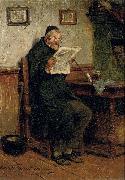 |
Hugo Wilhelm Kauffmann
|
|
(7 August 1844 - 30 December 1915) was a German painter, the son of Hermann Kauffmann.
Kauffmann was born in Hamburg. In 1861 he went to Frankfurt and worked there under Jakob Becker, Edward Jakob von Steinle and Johann Nepomuk Zwerger. From 1863-71 he lived in Kronberg in the Taunus. During this time he spent one winter in Hamburg and a five-month period in Desseldorf too; afterwards he spent 1½ years in Paris, until 1870 when the war drove him out. He lived until 1871 in Munich. He died in Prien at the Chiemsee in 1915.
|
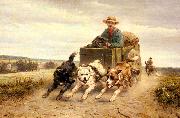 |
Henriette Ronner-Knip
|
|
was a Dutch painter.
Born Henriëtte Knip in Amsterdam, she moved at a young age to Den Bosch and was until 1850 active in Sint-Michielsgestel and Boxtel. That year she married Feico Ronner and moved to Belgium, first to Brussels and in 1878 to Elsene. She studied with her father, Joseph August Knip.
She was best known for her paintings of subjects from nature, especially cats and dogs.
|
 |
Hans von Kulmbach
|
|
(real name Hans Suess or Hans Seß) was born around 1480 in Kulmbach, Franconia and died previous to Dec. 3, 1522 in Nuremberg. Hans von Kulmbach was the artist who created the Krakew St. John's Altar.
Kulmbach probably arrived in Nuremberg around 1505. He received instruction by Jacopo de' Barbari, who for a time worked in Nuremberg. Von Kulmbach then apprenticed with Albrecht Derer and after Derer retired from painting altarpieces in 1510 Kulmbach took over most of his commissions. Kulmbach had his own workshop in Nuremberg and at times worked in Krakew. He also created artworks for emperor Maximilian I and for Margrave Casimir Hohenzollern von Brandenburg-Kulmbach. His best works were stained-glass windows in churches, such as the Maximilian stained-glass, Margrave stained-glass at St. Sebald in Nuremberg, the Welser stained-glass at the Frauenkirche and the Nikolaus altar at Lorenzkirche. In 1511 he finished the St. Mary's altar at Skałka in Krakew. The Catherine and St. John's altar also in Krakew, are among his best works.
|
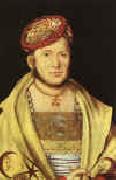 |
Hans Suss von Kulmbach
|
|
1476-1522
German
Hans Suss von Kulmbach Gallery
German painter and graphic artist. His real name was Hans S??ss. In general his work reveals the influence of D??rer, but he had little of the master's power. Von Kulmbach worked chiefly in Nuremberg, although he probably spent several years in Cracow as court painter. His masterpiece is the Tucher altarpiece for the Church of St. Sebald in Nuremberg. He also executed portraits and designs for painted glass.
|
 |
Hans Knieper
|
|
painted Portrait of Frederick II of Denmark and Norway in 1581
|
 |
Gustav Klimt
|
|
Austrian Art Nouveau Painter, 1862-1918
Gustav Klimt (July 14, 1862 ?C February 6, 1918) was an Austrian Symbolist painter and one of the most prominent members of the Vienna Art Nouveau (Vienna Secession) movement. His major works include paintings, murals, sketches, and other art objects, many of which are on display in the Vienna Secession gallery. Klimt's primary subject was the female body, and his works are marked by a frank eroticism--nowhere is this more apparent than in his numerous drawings in pencil.
Klimt's work is distinguished by the elegant gold or coloured decoration, often of a phallic shape that conceals the more erotic positions of the drawings upon which many of his paintings are based. This can be seen in Judith I (1901), and in The Kiss (1907?C1908), and especially in Danaë (1907). One of the most common themes Klimt utilized was that of the dominant woman, the femme fatale. Art historians note an eclectic range of influences contributing to Klimt's distinct style, including Egyptian, Minoan, Classical Greek, and Byzantine inspirations. Klimt was also inspired by the engravings of Albrecht D??rer, late medieval European painting, and Japanese Rimpa school. His mature works are characterized by a rejection of earlier naturalistic styles, and make use of symbols or symbolic elements to convey psychological ideas and emphasize the "freedom" of art from traditional culture. |
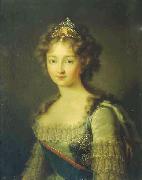 |
Gerhard von Kugelgen
|
|
Franz Gerhard von Kegelgen (February 26, 1772 - March 27, 1820) was a German painter, noted for his portraits and history paintings. He was a professor at the Academy of Arts in Dresden and a member of both the Prussian and Russian Academies of Arts. His twin brother, Karl von Kegelgen, was also a painter of note.
Gerhard von Kegelgen was born at Bacharach am Rhein. After leaving school in 1789, he studied painting in Koblenz. Beginning in 1791, he worked in Bonn, where he painted portraits of Elector Archduke Maximilian Franz of Austria, minister Ferdinand August von Spiegel zum Desenberg, and the Earl of Waldstein. Afterwards, Gerhard von Kegelgen and his brother undertook an educational journey to Rome, Munich and Riga, which was financed by Maximilian Franz of Habsburg.
In 1800, Kegelgen married Helene Marie Zoege von Manteuffel. They had three children together. His first son, Wilhelm was born in Saint Petersburg in 1802, and also grew up to become a painter. The other children were Gerhard (born 1806), and Adelheid (born 1808).
|
 |
George Knapton
|
|
George Knapton (1698-1778) was an English portrait painter and the first portraitist for the Society of Dilettanti in the 1740s. He became Surveyor and Keeper of the King's Pictures from 1765-1778.
Knapton was born in London, the son of James Knapton, a Bookseller of Ludgate street. He studied art under Jonathan Richardson, then at the St. Martin's Lane Academy. He spent some years in Italy where he became known as a sound judge of the works of the "Old Masters". An account of his vist to Herculaneum was published in the "Philosophical Transactions" of 1740 (no. 458).
Knapton was an original member of the "Society of Dilettanti" and their first portrait artist. He painted many members of the society - mostly in fancy dress - including the Duke of Dorset, Viscount Galway, Sir Francis Dashwood, the Earl of Holdernesse, Earl of Bessborough and Sir Bourchier Wray. Knapton resigned his position at the society in 1763.
In 1750, the then Prince of Wales commissioned Knapton, together with George Vertue, to produce a catalogue of the pictures at Kensington Palace, Hampton Court and Windsor castle. In 1765, he succeeded Stephen Slaughter as Surveyor and Keeper of the King's Pictures; he was also in charge of Lord Spencer's collection at Althorp, Northamptonshire.
The Family of Frederick, Prince of Wales (1751)Knapton's largest painting was that of the widowed Princess of Wales and her family (1751). He also painted portraits of the Earl of Upper Ossory (with his brother and sister), the Earl of Burlington, Admiral Sir John Norris, Francis, Fifth Duke of Leeds, Admiral George Vandeput, Archibald Bower, Nicolas Tindal, Hildebrand Jacob, Admiral Edward Hawke, and the singers Carestini and Lisabetta du Parc.
Kanpton assisted his brothers, John and Paul - who had succeeded to and extended their father's business - in the production of several publications including works by Thomas Birch and "The History of England" by Nicolas Tindal and Paul de Rapin.
Knapton died in Kensington in December 1778 and was buried there on the 28th of that same month. |
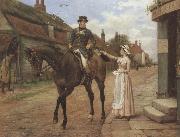 |
George goodwin kilburne
|
|
1839-124
was a London based genre painter specialising in accurately drawn interiors with figures. He favoured the watercolour medium, although he did also work in oils, pencil and in his early career engraving.George was born on the 24th July 1839 in Norfolk. He was apprenticed for five years to the Dalziel brothers in London, studying wood engraving. He married Jenny Dalziel, the daughter of Robert Dalziel - they had three sons and two daughters: George Goodwin Jnr who also became an artist; Charles Robert, William Richard, Florence and Mary Maud. They all lived together at Hawkhurst House, Steeles Road, Hampstead. George abandoned wood engraving for the more versatile and profitable mediums of watercolour and oil painting. His apprenticeship in engraving enhanced the accuracy and detail of his paintings. He quickly became on of the most sought after and well known artists in England. George's wife Janet died in March 1883 and George later married Edith Golightly with who he had two girls, Constance Ivy and Edith May. George's paintings often portrayed the upper classes and ultra-fashionable female beauties in opulent settings. His depiction of this beauty was heightened by his attention to detail with dress, and richly decorated interiors. |
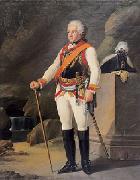 |
Georg Melchior Kraus
|
|
(26 July 1737, Frankfurt am Main - 5 November 1806, Weimar) was a German painter. A student of Johann Heinrich Tischbein, he was also a teacher himself (his pupils included Ferdinand Jagemann), as well as an entrepreneur and friend of Goethe. He was a co-founder of the Ferstliche freie Zeichenschule Weimar with Friedrich Justin Bertuch in 1776.
|
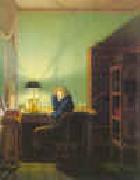 |
Georg Friedrich Kersting
|
|
1785-1847
German
Georg Friedrich Kersting Gallery
Kersting was a friend of Caspar David Friedrich, the leading German Romantic painter; his style was influenced by Friedrich, and he shared that artist's romantic attitude, although in a more subjective manner. The two friends went on a walking tour of the Riesengebirge in 1810. During his many hikes with Friedrich, the two painted numerous sketches and observations from nature. He may have painted the staffage in some of Friedrich's early work??such as Morning in the Riesengebirge (1810?C11), a result of their walking tour.
He was also a friend of the painter Louise Seidler, who described him as "an altogether splendid and comical fellow" and often served as his model. In 1813 Seidler helped Kersting send a number of his works to Johann Wolfgang von Goethe. Goethe was impressed and recommended that the Grand Duke Charles Augustus purchase his work The Embroiderer.
Kersting's most lasting works are his figures in interiors that borrow from seventeenth-century Dutch genre painting. These paintings nevertheless feel contemporary due to the situations depicted and the effect of the artist's personality. The characters are often viewed from the back, as in Friedrich's work, and the scenes provide hints of narrative as the figures engage privately in everyday activities. A number of his works refer to his time in the volunteer corps, the "L??tzow rangers". He drew a full-length self-portrait in 1813, in which he wore the rangers' uniform. The painting On Sentry Duty (1815) depicts three rangers, including the artist Ferdinand Hartmann and the writer Theodor Körner, who fought with Kersting and died in wars against the French. |
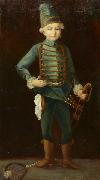 |
Friedrich August von Kaulbach
|
|
(2 June 1850, Hannover - 26 July 1920, Munich, Germany) was a German portraitist and historical painter. He was the son of Theodor Friedrich Wilhelm Christian Kaulbach (1822 - 1903), the court painter at Hannover, and the great nephew of Wilhelm Kaulbach, another prominent member of the Kaulbach family of artists. He learned to paint from his father, and later was a student of August von Kreling at Nuremberg. He sought to emulate the artist Hans Holbein. |
 |
Franz Kops
|
|
painted Ir. konigl. Hoheit Prinz Georg, Herzog zu Sachsen im Jahre 1895 - Studie nach dem Leben in 1895 |
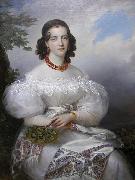 |
Francois Joseph Kinson
|
|
François-Joseph Kinson (1771-1839) was a Flemish painter.
Kinson attended art school at Bruges and soon established a reputation in Ghent and Brussels. He exhibited a portrait in Paris in 1799. Settling in Paris after the exhibition, the artist courted the favor of the rich and famous of the time. Kinson worked for Napoleones court and eventually became court painter to Jerôme Bonaparte, King of Westphalia. Kinson is best remembered for his portraits of elegant women. The artist worked as a court painter in Paris until 1830, and died in 1839 at the age of 68.
|
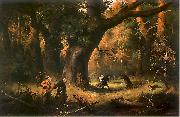 |
Franciszek Kostrzewski
|
|
(19 April 1826 in Warsaw - 30 September 1911 in Warsaw) was a Polish painter, illustrator and caricaturist.
He was born in Warsaw, Congress Poland, Russian Empire. Among his works are paintings illustrating the epic poem Pan Tadeusz. He died in Warsaw.
|
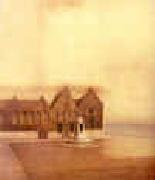 |
Fernand Khnopff
|
|
1858-1921 Belgian Fernand Khnopff Gallery Fernand Khnopff was born to a wealthy family that was part of the high bourgeoisie for generations. Khnopff's ancestors had lived in Flanders since the early 17th-century but were of Austrian and Portuguese descent. Most male members of his family had been lawyers or judges, and young Fernand was destined for a juridical career. In his early childhood (1859-1864) he lived in Bruges where his father was appointed Substitut Du Procureur Du Roi. His childhood memories of the medieval city of Bruges would play a significant role in his later work. In 1864 the family moved to Brussels. To please his parents he went to law school at the Free University of Brussels (now divided into the Universite Libre de Bruxelles and the Vrije Universiteit Brussel) when he was 18 years old. During this period he developed a passion for literature, discovering the works of Baudelaire, Flaubert, Leconte de Lisle and other mostly French authors. With his younger brother Georges Khnopff - also a passionate amateur of contemporary music and poetry - he started to frequent Jeune Belgique ("Young Belgium"), a group of young writers including Max Waller, Georges Rodenbach, Iwan Gilkin and Emile Verhaeren. Khnopff left University due to a lack of interest in his law studies and began to frequent the studio of Xavier Mellery, who made him familiar with the art of painting. On the 25th of October 1876 he enrolled for the Cours De Dessin Apres Nature ("course of drawing after nature") at the Academie Royale des Beaux-Arts en Bruxelles. At the Academie, his most famous fellow student was James Ensor, whom he disliked from the start. Between 1877 and 1880 Khnopff made several trips to Paris where he discovered the work of Delacroix, Ingres, Moreau and Stevens. At the Paris World Fair of 1878 he became acquainted with the oeuvre of Millais and Burne-Jones. During his last year at the Acad??mie in 1878-1879 he neglected his classes in Brussels and lived for a while in Passy, were he visited the Cours Libres of Jules Joseph Lefebvre at the Acad??mie Julian. |
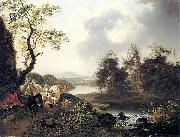 |
Ferdinand Kobell
|
|
(born in Mannheim, 7 June 1740; died in Munich, 1 February 1799) was a German painter and engraver.
He was studying at the University of Heidelberg when the Elector of Bavaria, admiring a landscape, aided him to devote his entire time to painting. He became the pupil of Peter Verschaffelt. He next studied art in Paris (1768-1769). On his return, he was appointed painter to the Cabinet (court painter), and later professor at the Academy. In 1793, he moved to Munich. He was appointed director of the Mannheim Gallery (1798) but died before entering on his duties.
|
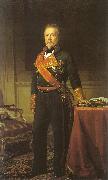 |
Federico de Madrazo y Kuntz
|
|
1815-1894
Spanish
Federico de Madrazo y Kuntz Gallery
Born in Rome, he was the son of the painter Madrazo y Agudo (1781-1859), and received his first instruction from his father. While still attending the classes at the Royal Academy of San Fernando, he painted his first picture, The Resurrection of Christ (1829), which was purchased by Queen Christina. Not long afterwards he painted Achilles in his Tent, and subsequently presented to the Academy The Continence of Scipio, which secured him admission as a member "for merit".
While decorating the palace of Vista Alegre he took up portraiture. In 1852 he went to Paris, where he studied under Franz Winterhalter, and painted portraits of Baron Taylor and Ingres. In 1837 he was commissioned to produce a picture for the gallery at Versailles, and painted "Godfrey de Bouillon proclaimed King of Jerusalem". The artist then went to Rome, where he worked at various subjects, sacred and profane. Then he painted Maria Christina in the Dress of a Nun by the Bedside of Ferdinand III (1843), Queen Isabella, The Duchess of Medina-Coeli, and The Countess de Vilches (1845-1847), besides a number of portraits of the Spanish aristocracy, some of which were sent to the exhibition of 1855.
He received the Legion of Honour in 1846. He was made a corresponding member of the Paris Academy of Fine Arts on 10 December 1853, and in 1873, on the death of Schnorr, the painter, he was chosen foreign member. After his father's death he succeeded him as director of the Museo del Prado and president of the Academy of San Fernando. He originated in Spain the production of art reviews and journals, such as El Artiste, El Renacimiento, and El Semanario pintoresco. He died at Madrid in 1894.
|
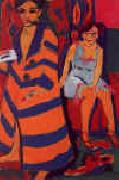 |
Ernst Ludwig Kirchner
|
|
German Expressionist Painter and Sculptor, 1880-1938 was a German expressionist painter and printmaker and one of the founders of the artists group Die Brucke or "The Bridge", a key group leading to the foundation of Expressionism in 20th century art. He volunteered for army service in the First World War, but soon suffered a breakdown and was discharged. In 1933, his work was branded as "degenerate" by the Nazis and in 1937 over 600 of his works were sold or destroyed. In 1938 he committed suicide. In 1913, the first public showing of Kirchner's work took place at the Armory Show, which was also the first major display of modern art in America. In 1921, U.S. museums began to acquire his work and did so increasingly thereafter. His first solo show was at the Detroit Institute of Arts in 1937. In 1992, the National Gallery of Art, Washington, held a monographic show, using its existing collection; a major international loan exhibition took place in 2003. In November 2006 at Christie's, Kirchner's Street Scene, Berlin (1913) fetched $38 million, a record for the artist. |
 |
Edward Knowles
|
|
(born 1868 in Waberthwaite e died 29 June 1945 in Skiptone) was a rugby union footballer of the 1890s who at representative level played for England, and at club level for Millom,playing in the Forwards, e.g. Front row, Lock, or Back row. Prior to the 1899/1900 season, Millom was a rugby union club.
|
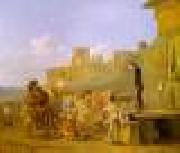 |
DUJARDIN, Karel
|
|
Dutch Baroque Era Painter, ca.1622-1678
Dutch painter and etcher. He studied with Berchem and in Italy. Dujardin was particularly successful in painting landscapes with figures and animals, and he made some 51 fine etchings of similar subjects. |
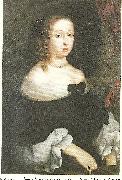 |
david von krafft
|
|
David von Krafft, konstnär, målare, född 1655 i Hamburg, död 1724 i Stockholm.
David von Krafft blev kallad till Sverige 1675 av hofkonterfejaren (hovmålaren) David Klöcker Ehrenstrahl, som dessutom var hans morbror och nu även blev hans lärare i den ädla konsten att måla. Senare studerade von Krafft vidare ett tiotal år i utlandet, särskilt i Italien, slutligen blev han Ehrenstrahls ersättare som hovmålare.
Nu fick han en massa beställningar och uppdrag och han målade sakliga och säkert tecknade porträtt, som tyvärr dock är ganska entoniga och kalla i koloriten. Bland hans bästa arbeten är porträttet av Karl XII (finns i Lund) samt av Carl Gustaf Armfeldt d.ä. (Drottningholms slott). I Kalmar domkyrka har han målat altartavlan (dock efter en komposition av en italiensk konstnär).
David von Krafft finns representerad vid Nationalmuseum, Malmö Museum, Göteborgs konstmuseum och på Gripsholm. Krafft hade ett stort antal lärjungar och bland dem Gustaf Lundberg och Olof Arenius. |
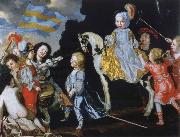 |
David Klocker Ehrenstrahl
|
|
German, 1629-1698,Swedish nobleman and portrait painter who in 1652, at twenty-four years of age, at the request of Carl Gustaf Wrangel, moved to Skokloster Castle, from his art studies in the Netherlands. Between 1654 and 1661 he studied in Italy and visited the courts of both France and England. On his return he became entitled Court painter. He was raised to the nobility in 1674 and became court indendant in 1690. Mikael Dahl and David von Krafft as well as his daughter Anna Maria (born 1666) can be found among his pupils. The allegoric great hall ceiling fresco, named The Great Deeds of The Swedish Kings, in the Swedish House of Knights, made between 1670 and 1675, is considered to be his greatest work. A second version was made in Drottningholm Palace, the home of the Swedish Royal Family, in 1695. The Drottningholm fresco, also became the motive of the 1000th and ever largest postage stamp by Czeslaw Slania, the Polish |
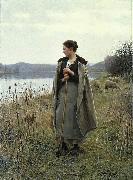 |
Daniel Ridgway Knight
|
|
(March 15, 1839 - March 9, 1924) was an American artist born at Philadelphia, Pennsylvania. He was a pupil at the Ecole des Beaux-Arts, Paris, under Gleyre, and later worked in the private studio of Meissonier. After 1872 he lived in France, having a house and studio at Poissy on the Seine.
Spring BlossomsHe painted peasant women out of doors with great popular success. He was awarded the silver medal and Cross of the Legion of Honor, Exposition Universelle, Paris, 1889, and was made a Knight of the Royal Order of St. Michael of Bavaria, Munich, 1893, and receiving the gold medal of honor from the Pennsylvania Academy of the Fine Arts, Philadelphia, 1893. His son, Louis Aston Knight (1873 - 1948), is also known as a landscape painter.
|
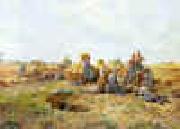 |
Daniel Ridgeway Knight
|
|
1839-1924
Daniel Ridgeway Knight Gallery
Daniel Ridgway Knight was born on March 15,1839 in Pennsylvania. He studied and exhibited at the Pennsylvania Academy of the Fine Arts, were he was a classmate of Mary Cassatt and Thomas Eakins. In 1861, he went to Paris to study at L'Ecole des Beaux-Arts under Cabanel, and to apprentice in the atelier of Charles-Gabriel-Gleyere. |
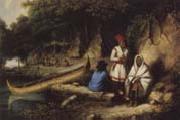 |
Cornelius Krieghoff
|
|
Dutch-born Canadian Painter, 1815-1872
Canadian painter of Dutch birth. He learnt the rudiments of music and painting from his father and about 1830 attended the Akademie der Bildenden Kenste in D?sseldorf. He moved to America c. 1835 and enlisted in the US army. In New York he met Louise Gauthier, a French-Canadian, and settled in Montreal with her in 1840, working as a painter and a musician. In 1842-3 he had a studio in Rochester, NY; in the following year he studied in Paris, making copies in the Louvre. Returning to Canada in 1845, he painted portraits in Toronto, and from 1845 to 1853 he lived in Longueuil and then in Montreal, where he produced genre paintings, landscapes and portraits. He exhibited in Montreal and Toronto, and a series of lithographs were published after his drawings. However, he found it difficult to sell his work in Montreal and had to resort more or less completely to sign-painting for a living. About 1853, at the instigation of the auctioneer John Budden, Krieghoff settled in Quebec City. He lived there for 11 years, making several trips to Europe. During this period of intensive production, he achieved popularity and prosperity and painted his best-known pictures, which were scenes depicting the local townspeople and the North American Indians, and views of Quebec City and the surrounding region. About 1858 he made panoramic paintings of Canada for the Provincial Parliament buildings in Quebec. From 1864 to 1867 he lived in Paris and Munich, |
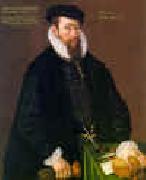 |
Cornelis Ketel
|
|
Flemish (Resident in UK)
1548-1616 Cornelis or Cornelius Ketel (Gouda, 18 March 1548 ?C Amsterdam, 8 August 1616) was a Dutch Mannerist painter, active in Elizabethan London from 1573 to 1581, and in Amsterdam from 1581 to the early 1600s, now known essentially as a portrait-painter, though he was also a poet and orator, and from 1595 began to sculpt as well.
According to Ketel's biography, written by his contemporary Karel van Mander, he seems to have wanted to concentrate on the most prestigious of the hierarchy of genres, history painting, which included mythological subjects, but after he left France he is known almost entirely as a portrait-painter. Neither England nor Holland had much demand for large history paintings during his lifetime, and none of Ketel's histories or allegorical paintings are known to have survived intact, although drawings and prints survive. He did however significantly influence the development of the largest type of painting commonly produced in the United Provinces at this period, the civic group portrait
|
|

